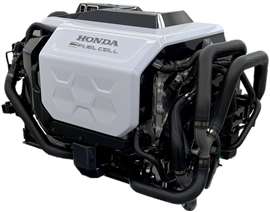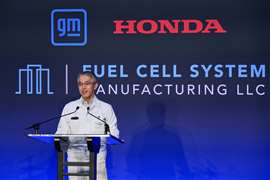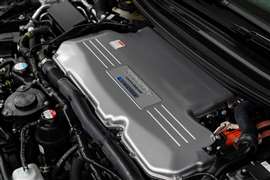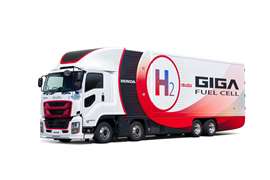Honda starts series production of fuel cells
05 February 2024
 The next-gen Honda fuel cell system (Photo: Honda)
The next-gen Honda fuel cell system (Photo: Honda)
Honda has started series production of fuel cells (FC) at its Fuel Cell System Manufacturing (FCSM) facility in Brownstown, Michigan. The plant is a joint venture with General Motors, which will also use fuel cells produced by the facility.
This latest fuel cell system is said to be key to Honda’s future hydrogen business strategy. Co-developed by Honda and GM over the last decade, it is reported that the new FC is twice as durable as the model it replaces due to corrosion-resistant materials.
Costs are said to have been reduced by about 66% through simplification of auxiliary components, common sourcing, economies of scale and reduced use of precious metals.
“We integrated the strengths of Honda and GM to create the most capable production system at this joint venture,” said Tetsuo Suzuki, vice president of FCSM. “We brought a mass production mindset with attention to detail and a focus on high quality, and now we are ready to meet the needs of the customers for the future applications of fuel cell technology and the beginning of the hydrogen era.”
 Tetsuo Suzuki speaking at the opening of the Fuel Cell System Manufacturing facility (Photo: Honda)
Tetsuo Suzuki speaking at the opening of the Fuel Cell System Manufacturing facility (Photo: Honda)
The Japanese company views hydrogen as a key strategy to achieving its ‘Triple Action to Zero’. This has the goal of achieving zero environmental impact across all Honda products, while extending that through the product lifecycle.
FC domains
Honda has identified four ‘domains’ which can potentially benefit from the new FC system: FCEVs; commercial fuel cell vehicles; stationary power; and construction machinery.
While initial production at FCSM will be used to support internal Honda initiatives and production of FCEVs, the company is exploring additional business opportunities. As it stands, the goal is to reach a production target of 2000 units per year and expand further over a series of stages.
 Honda FC in the upcoming CR-V FCEV - more details will be available closer to launch (Photo: Honda)
Honda FC in the upcoming CR-V FCEV - more details will be available closer to launch (Photo: Honda)
The all-new CR-V FCEV will enter production this year at the Honda Performance Manufacturing Center (home of the NSX supercar) based at the plant in Marysville, Ohio. It effectively replaces the second-generation FCX Clarity which was produced through 2015 and will be the only FCEV produced in the US.
Power applications
At the Japan Mobility Show 2023, held in Tokyo in October, Honda and Isuzu Motors previewed the Giga Fuel Cell. Using a solid polymer Honda fuel cell stack, the truck has a range in excess of 800 km (500 miles). In addition, it can serve as a mobile power station in a disaster scenario.
There are plans to launch a test vehicle by the end of the current fiscal year (March 31, 2024). This would be followed by the launch of a market-ready vehicle in 2027.
 Honda Giga Fuel Cell heavy-duty truck (Photo: Honda)
Honda Giga Fuel Cell heavy-duty truck (Photo: Honda)
Additionally, Honda has deployed fuel cells as power stations at its campus in Torrence, California. In December 2023, another FC power station was added at a datacentre operated by Mitsubishi. There are plans to roll out similar systems at other datacentres, supported by investment in related national hydrogen production ventures.
Background history
Honda has been working on development of fuel cell technology for more than 30 years. The Japanese vehicle OEM, which is also reported to be the largest manufacturer of internal combustion engines – about 14 million each year – had limited success with its Clarity passenger car program. But the high cost which prevented wider adoption is expected to be addressed with new FC production.




